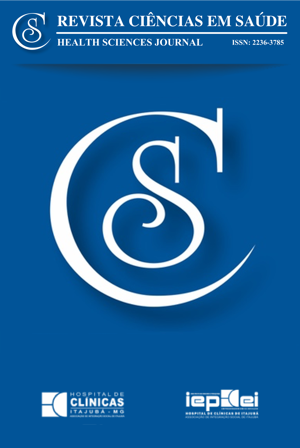Multisystem inflammatory syndrome in children associated with COVID-19: nursing care
Main Article Content
Abstract
In 2019, a new viral disease, known as SARS-Cov-2 infection, was identified. Scientists believed that it was a disease with low morbidity for pediatric patients; however, a small percentage of children infected with the new coronavirus developed a multisystem inflammatory response, which aroused the interest of many researchers and health professionals. The objective of the study is to describe the main characteristics related to the Pediatric Multisystemic Inflammatory Syndrome Associated with Covid-19 (MIS-C), its complications and nursing care. The main clinical manifestations of MIS-C are hyperthermia, gastrointestinal symptoms, skin manifestations, generalized lymphadenopathy, cardiac and neurological disorders. The main nursing care was listed according to the signs and symptoms, such as monitoring of neurological and hydroelectrolytic changes. The nurse professional must add knowledge about MIS-C so that he is able to qualify his care and improve his skills to provide quality care to pediatric patients.
Article Details
Authors maintain copyright and grant the HSJ the right to first publication. From 2024, the publications wiil be licensed under Attribution 4.0 International 
 , allowing their sharing, recognizing the authorship and initial publication in this journal.
, allowing their sharing, recognizing the authorship and initial publication in this journal.
Authors are authorized to assume additional contracts separately for the non-exclusive distribution of the version of the work published in this journal (e.g., publishing in an institutional repository or as a book chapter), with acknowledgment of authorship and initial publication in this journal.
Authors are encouraged to publish and distribute their work online (e.g., in institutional repositories or on their personal page) at any point after the editorial process.
Also, the AUTHOR is informed and consents that the HSJ can incorporate his article into existing or future scientific databases and indexers, under the conditions defined by the latter at all times, which will involve, at least, the possibility that the holders of these databases can perform the following actions on the article.
References
Campos L, Cardoso T, Martinez J, Almeida R, Silva R, Fonseca A, et al. Pediatric inflammatory multisystem syndrome (PIMS) temporally related to SARS-CoV-2. Resid Pediatr. 2020;10(2):1-6. https://doi.org/10.25060/residpediatr-2020.v10n2-348
Brasil, Ministério da Saúde, Universidade Federal do Rio Grande do Sul. Síndrome Inflamatória Multissistêmica Pediátrica (SIM-P): Associada à Covid-19. Porto Alegre: Universidade Federal do Rio Grande do Sul; 2020. 12 p. Available from: https://bit.ly/3ibaTP8
Brasil, Ministério da Saúde. Guia de Vigilância Epidemiológica. Versão 3. 2021 Mar 15 [cited 2021 May 21]. Avaiable from: https://bit.ly/2RCxdXd
Nakra NA, Blumberg DA, Herrera-Guerra A, Lakshminrusimha S. Multi-System Inflammatory Syndrome in Children (MIS-C) following SARS-CoV-2 infection: review of clinical presentation, hypothetical pathogenesis, and proposed management. Children (Basel). 2020;7(7):69. https://doi.org/10.3390/children7070069 PMid:32630212 PMCid:PMC7401880
Brasil, Ministério da Saúde, Secretaria de Vigilância em Saúde. Boletim Epidemiológico Especial 52. Brasilia, DF: Ministério da Saúde; 2021 Mar 4 [cited 2021 May 23]. Avaiable from: https://bit.ly/3fDIChj
Ramos R, Silva D, Araújo G, Riedi C, Ibiapina C, Bezerra P, et al. Aspectos respiratórios da COVID-19 na infância: o que o pediatra precisa saber? Resid Pediatr. 2020;10(2):1-15. https://doi.org/10.25060/residpediatr-2020.v10n2-349
Ye Q, Wang B, Mao J. The pathogenesis and treatment of the 'Cytokine Storm' in COVID-19. J Infect. 2020;80(6):607-13. https://doi.org/10.1016/j.jinf.2020.03.037 PMid:32283152 PMCid:PMC7194613
Zhang C, Wu Z, Li J, Zhao H, Wang G. Cytokine release syndrome in severe COVID-19: interleukin-6 receptor antagonist. Int J Antimicrob Agents. 2020;55(2020):105954-60. https://doi.org/10.1016/j.ijantimicag.2020.105954 PMid:32234467 PMCid:PMC7118634
World Health Organization (WHO). Multisystem inflammatory syndrome in children and adolescents with COVID-19 [Internet]. WHO;2020. Available from: https://bit.ly/3oKnLwR
Center for Diesease Control and Prevention (CDC). Multisystem Inflammatory Syndrome in Children (MIS-C) Associated with Coronavirus Disease 2019 (COVID-19) [Internet]. Atlanta: CDC; 2020 [cited 2021 May 23]. Available from: https://emergency.cdc.gov/han/2020/han00432.asp
Ministério da Saúde, Fiocruz, Instituto Nacional de Saúde da Mulher, da Criança e do Adolescente Fernandes Figueira. Covid-19 e Saúde da Criança e do Adolescente [Internet]. Rio de Janeiro, RJ; Fiocruz. 2020 [cited 2021 May 23]. Avaiable from: https://bit.ly/3vl8eXa
Toubiana J, Poirault C, Corsia A, Bajolle F, Fourgeaud J, Angoulvant F, et al. Kawasaki-like multisystem inflammatory syndrome in children during the covid-19 pandemic in Paris, France: prospective observational study. BMJ. 2020;369:m2094. https://doi.org/10.1136/bmj.m2094 PMid:32493739 PMCid:PMC7500538
Sociedade Brasileira de Pediatria (SBP). Notificação obrigatória no Ministério da Saúde dos casos de síndrome inflamatória multissistêmica pediátrica (SIM-P) potencialmente associada à COVID-19 [Internet]. Rio de Janeiro, RJ: SBP; 2020 [cited 2021 May 23]. Avaiable from: https://bit.ly/2SnbJxj
Pereira de Sá DC. Síndromes de choque tóxico / Toxic shock syndromes [Masters Dissertation]. Porto: Universidade do Porto, Faculdade de Medicina; 2018 [cited 2021 May 23]. Avaiable from: https://bit.ly/3yAdNmw
Correia MSR. Síndrome Hemofagocítico em idade pediátrica: novas perspetivas no diagnóstico e terapêutica [Masters Dissertation]. Lisboa: Faculdade de Medicina de Lisboa; 2019 [cited 2021 May 23]. Avaiable from: https://bit.ly/3hNjlnz
Suassuna JHR, Lima EQ, Rocha E, Castro A, Burdmann EA, Carmo LPF, et al. Nota técnica e orientações clínicas sobre a Injúria Renal Aguda (IRA) em pacientes com Covid-19: Sociedade Brasileira de Nefrologia e Associação de Medicina Intensiva Brasileira. Braz J Nephrol. 2020;42(2 suppl 1):22-31. https://doi.org/10.1590/2175-8239-JBN-2020-S107
Associação de Medicina Intensiva Intensiva, Sociedade Brasileira de Pneumologia e tisiologia. Diretrizes Brasileiras de Ventilação Mecânica 2013 [Internet]. AMIB, SBPT; 2013 [cited 2021 May 23]. 140 p. Avaiable from: https://bit.ly/3fEoBXV
Kattan J, González Á, Castillo A, Caneo LF. Neonatal and pediatric extracorporeal membrane oxygenation in developing Latin American countries. J Pediatr. 2017;93(2):120-9. https://doi.org/10.1016/j.jpedp.2017.01.002
Taets G, Barbosa J, Bitencourt G, Taets CC. Functional health standards in adults with COVID-19 in intensive care: a rationale for nursing diagnoses. SciELO Preprints. 2020. https://doi.org/10.1590/SciELOPreprints.516
Santana ET, Coutinho GG, Silva DVA, Bernardes TAA, Camisasca LR, Gusmão ROM, et al. Diagnósticos de enfermagem da taxonomia NANDA-I para idosos em instituição de longa permanência. Esc Anna Nery. 2021;25(1):e20200104. https://doi.org/10.1590/2177-9465-ean-2020-0104
Herdman TH, Kamitsuru S. Diagnósticos de Enfermagem NANDA-I: definições e classificação, 11ª edição, 2018-2020. Porto Alegre, RS: Artmed Editora LTDA; 2018. 1187 p. Avaiable from: https://bit.ly/349OfOX
Butcher HK, Dochterman JM, Bulecheck GM, Wagner CM (eds). Classificação das Intervenções em Enfermagem (NIC). 6ª ed. Rio de Janeiro, RJ: Guanabara Koogan; 2016. 640 p.
